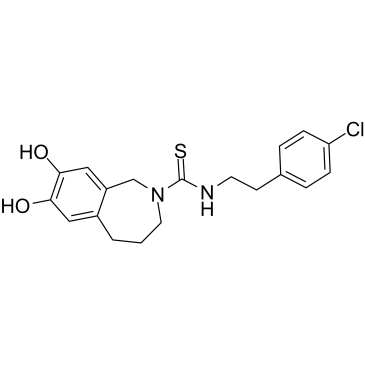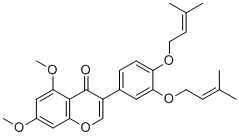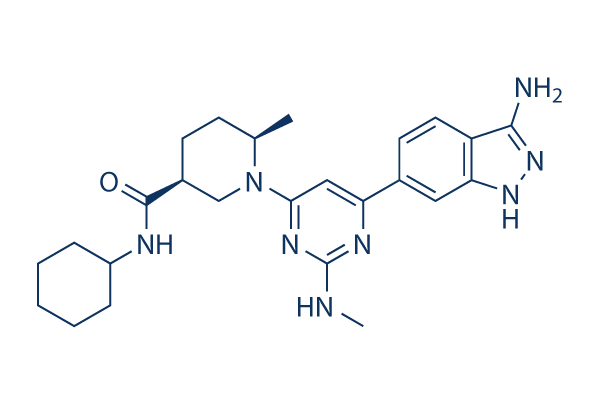 To enhance service speed and avoid tariff delays, we've opened a US warehouse. All US orders ship directly from our US facility.
To enhance service speed and avoid tariff delays, we've opened a US warehouse. All US orders ship directly from our US facility.
| Cat. No. | Product Name | Field of Application | Chemical Structure |
|---|---|---|---|
| DC9372 | 6-FAM SE Featured |
6-FAM SE is another isomer of carboxyfluorescein.
More description
|

|
| DC10854 | 6-MITC Featured |
6-MITC is an inhibitor of viability of both PANC-1 and BxPC-3 cells. It also acts as an inhibitor of the expression of CSC signaling molecule SOX2.
More description
|

|
| DC10855 | 7-Epi 10-Desacetyl Paclitaxel Featured |
7-Epi 10-Desacetyl Paclitaxel is a paclitaxel impurity. The compound, originally isolated from Taxus yunnanensis, has shown potential growth inhibitory activities against human cancer cells.
More description
|

|
| DC10856 | 7-Epipaclitaxel Featured |
7-epi-Taxol is a paclitaxel binds to tubulin, interfering with the normal function of microtubule.
More description
|

|
| DC22345 | Penthiopyrad Featured |
A carboxamide fungicide used to control a broad spectrum of diseases on large variety of corps.
More description
|

|
| DC34093 | EGFR inhibitor(YUN27078) Featured |
YUN27078, also known as EGFR inhibitor, is an EGFR inhibitor. It directly depolymerizes microtubules and is used as a chemical probe to investigate both the EGFR pathway and microtubule dynamics. YUN27078 hax CAS#879127-07-8, no formal name For the convenience of scientific communication, we named it as YUN27078 (combined from Inchi key plus CAS#) according to Hodoodo Chemical Nomenclature
More description
|

|
| DC7952 | Capasazepine Featured |
Capsazepine is a synthetic analogue of the sensory neurone excitotoxin, capsaicin; potent TRPV1 receptor antagonist with IC50 of 562 nM.
More description
|

|
| DC21049 | Glabrescione B Featured |
Glabrescione B (GlaB) is a small molecule binding to Gli1 zinc finger and impairing Gli1 activity by interfering with Gli1/DNA interaction, inhibits Hh signaling by impairing Gli1 function; inhibits the growth of Hedgehog-dependent tumor cells in vitro and in vivo, inhibits Gli1-dependent growth of cerebellum-derived normal progenitors; inhibits the growth of Gli-dependent medulloblastoma and tumor-derived stem-like cells; inhibits the growth of Gli-dependent basal cell carcinoma in vitro and in vivo.
More description
|

|
| DC7650 | GSK2334470 Featured |
GSK2334470 is a novel PDK1 inhibitor with IC50 of ~10 nM, with no activity at other close related AGC-kinases.
More description
|

|
| DC22344 | Novaluron Featured |
A chemical with pesticide properties, belonging to the class of insecticides called insect growth regulators..
More description
|

|
| DC22347 | Penciclovir Featured |
A guanosine analogue antiviral agent used for the treatment of various herpesvirus (HSV) infections.
More description
|

|
| DC9843 | AKR1C3 Inhibitor 5f Featured |
A highly potent and selective inhibitor of the type 5 17-β-hydroxysteroid dehydrogenase AKR1C3.
More description
|

|
| DC8784 | CTLA-4 inhibitor Featured |
A novel CTLA-4 inhibitor.
More description
|

|
| DC10706 | Ehp-inhibitor-2 Featured |
A novel Ehp inhibitor
More description
|

|
| DC10705 | Ehp-inhibitor-1 Featured |
A novel Ehp inhibitor
More description
|

|
| DC24203 | P2X2/3 receptor antagonist Featured |
A novel P2X3 and P2X2/3 receptor antagonist useful for the treatment
of urinary tract diseases, pain, respiratory diseases and cardiovascular diseases.
More description
|

|
| DC23094 | TRAP-6 Featured |
A PAR1 peptide fragment (residues 42-47) that acts as a PAR1 agonist.
More description
|

|
| DC21560 | RC-3095 Featured |
RC-3095 is a gastrin-releasing peptide receptor antagonist, synergizes with gemcitabine to inhibit the growth of human pancreatic cancer CFPAC-1 in vitro and in vivo. RC-3095 inhibit the growth of human glioblastomas in vitro and in vivo. RC3095 inhibits tumor growth and decrease the levels and mRNA expression of epidermal growth factor receptors in H-69 small cell lung carcinoma.R,BRS-1) antagonist.
More description
|

|
| DC22890 | Frovatriptan Featured |
A potent, long lasting 5-HT(1B/1D) receptor agonist as a antimigraine agent..
More description
|

|
| DC22348 | Zalcitabine Featured |
A pyrimidine analog reverse transcriptase inhibitor (NRTI) for the treatment of HIV/AIDS.
More description
|

|
| DC23965 | Clopidogrel thiolactone Featured |
A thienopyridine-class antiplatelet agent that works by irreversibly inhibiting P2Y12 receptor on platelets.
More description
|

|
| DC12659 | A-381393 Featured |
A-381393 is a potent and selective agonist of the dopamine D4 receptor.
More description
|

|
| DC22277 | A-420983 Featured |
A-420983 is a potent, orally active inhibitor of lck with efficacy in a model of transplant rejection.
More description
|

|
| DC8161 | Xeglyze(Abametapir) Featured |
Abametapir is the active ingredient of Xeglyze Lotion.
More description
|

|
| DC24211 | Abiraterone (D4A) Featured |
Abiraterone (D4A) is an active metabolite of the CYP17A1 inhibitor abiraterone.
More description
|

|
| DC7352 | ABT-333 Featured |
ABT-333 is an NS5B non-nucleoside polymerase inhibitor.
More description
|

|
| DC10049 | Tebanicline(ABT-594) Featured |
ABT-594 represents a novel class of broad-spectrum analgesics whose primary mechanism of action is activation of the neuronal nicotinic acetylcholine receptors.
More description
|

|
| DC9262 | ABT-719 Featured |
ABT-719 is a potent bacterial DNA gyrase inhibitor.
More description
|

|
| DC9261 | ABT-719 HCl Featured |
ABT-719 is a potent bacterial DNA gyrase inhibitor.
More description
|

|
| DC12577 | AC-263093 Featured |
AC-263093 (AC263093) is a potent, functionally selective neuropeptide FF receptor type 2 (NPFFR2) agonist with pKi of 6.9.
More description
|

|